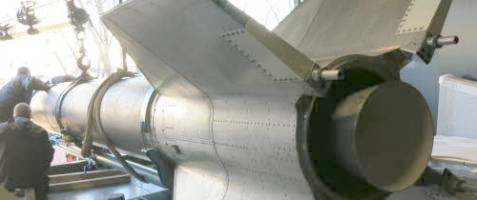|
EOLE |
|||||||||||||||||||||||||||||||||||||||
|
|
|||||||||||||||||||||||||||||||||||||||
|
|
|||||||||||||||||||||||||||||||||||||||
|
|||||||||||||||||||||||||||||||||||||||
|
|
|
EOLE |
|||||||||||||||||||||||||||||||||||||||
|
|
|||||||||||||||||||||||||||||||||||||||
|
|
|||||||||||||||||||||||||||||||||||||||
|
|||||||||||||||||||||||||||||||||||||||
|
Veronique-N |
||||||||||||||||||||||||||||||||||||||||||||||||||||||
|
A few months later, the LRBA Vernon began working on the project "4213". It was renamed for "Veronique". Two variants were produced: Veronique-N" and "Veronique-NA". They were 6.5 m and 7.3 m long with a diameter of 0.55 m. For propellants were used Diesel oil/Nitric Acid. The
propulsion system consists of three elements: gas generator, propellant tanks
and combustion chamber with direct injection. The nozzle is made of graphite
with steel reinforcement. A double wall allows the cooling due to the circulation
of a film of Nitric Acid. Through a series of holes in the injector-plate
is injected the oxidizer. The Veronique no turbos use to get in the motor
the propellants; the tank pressurization is achieved by the gas generator. |
||||||||||||||||||||||||||||||||||||||||||||||||||||||
|
||||||||||||||||||||||||||||||||||||||||||||||||||||||
|
|
|
|||||||||||||||||||||||||||||||||||||||||||||||||||||
|
|
|
|
Veronique (AGI, 61, 61M) |
||||||||||||||||||||||||||||||||||||||||||||||||||||||
The later produced "Veronique-AGI" and "Veronique-61 (M)" were changed. The new created LRBA-engines on the propellants Turpentine/Nitric Acid were based |
||||||||||||||||||||||||||||||||||||||||||||||||||||||
|
|
|
|||||||||||||||||||||||||||||||||||||||||||||||||||||
|
||||||||||||||||||||||||||||||||||||||||||||||||||||||
|
|
|
|||||||||||||||||||||||||||||||||||||||||||||||||||||
|
|
 |
|||||||||||||||||||||||||||||||||||||||||||||||||||||
|
Vesta |
||||||||||||||||||||||||||||||||||||||||||||||||||||||
|
|
||||||||||||||||||||||||||||||||||||||||||||||||||||||
|
||||||||||||||||||||||||||||||||||||||||||||||||||||||